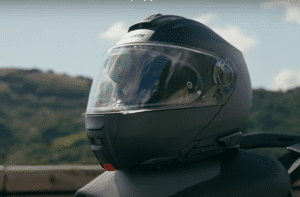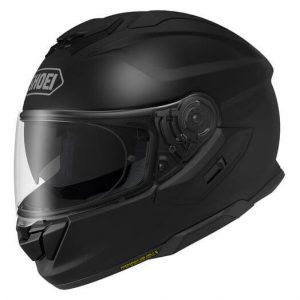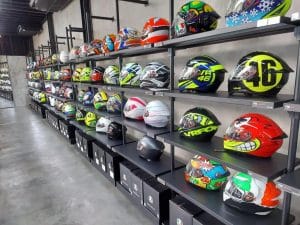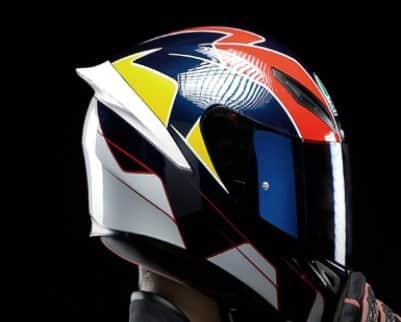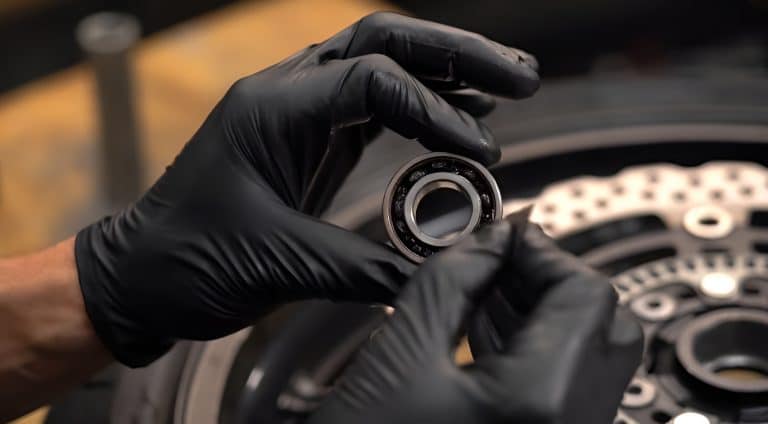Both Cardo BEYOND GT and GTS are full-face helmets designed for sport-touring riders and share the same core technology, including large 53 mm speakers, built-in mesh intercom, active noise cancellation (ANC), emergency crash sensors, and helmet health monitoring system. But they mainly differ in construction and feature set: the top-of-the-line BEYOND GTS features a lightweight carbon-fiber shell, while the more streamlined BEYOND GT uses a fiberglass-composite shell at a lower price point.
As someone who has followed Cardo’s innovations in rider communication and connectivity since 2003, I was immediately intrigued by the company’s bold move into fully integrated smart motorcycle helmets with the BEYOND GTS and BEYOND GT. Long regarded as the benchmark in Bluetooth and mesh systems for riders, Cardo is now taking a major leap by manufacturing helmets that embed its communication technology directly into the shell.
On first look, the company’s goal appears to combine advanced safety, seamless connectivity, and lasting rider comfort in one intelligent system. Still, rather than relying on marketing claims, I took time today to analyze whether the Beyond helmets truly live up to that promise.
BEYOND Helmets Launch Background and Industry Impact

I am sure I am not the only one who immediately thinks of Cardo or Sena when it comes to rider connectivity. Both brands have defined the standard for on-road communication, Cardo with its Packtalk series and Sena with its “S” line. Sena made its debut in 2010 with the SMH10, while Cardo revolutionized group intercom technology in 2015 with the Packtalk, the world’s first Dynamic Mesh Communication (DMC) system for motorcyclists.
Sena later expanded into helmet integration, launching its first smart helmet, the Outrush, in June 2020. That was followed by models like the Outrush R, Impulse, Stryker, Outride, Outforce, Outstar S, and Phantom, covering all major helmet categories: full-face, modular, and open-face.
Now, Cardo’s move on 29 October 2025 marks a new chapter. With the launch of the BEYOND GT and BEYOND GTS, the company has gone beyond (pun intended) standalone communicators and entered the fully integrated smart helmet segment. Developed with KISKA Design in Austria, the same studio behind KTM and Husqvarna’s signature motorcycles, the BEYOND series is manufactured by a company that also produces helmets for AGV, Alpinestars, Bell, Fox, and Klim.
And I immediately recognized how significant this move is. Cardo is now directly challenging Sena’s PHANTOM line, along with other smart-helmet innovators, like Forcite and CrossHelmet, by building the speakers, microphones, lights, sensors, and battery directly into the helmet shell. That factory-integrated approach eliminates bulky external modules or clip-on devices, creating a cleaner, safer, and more efficient system overall.
Cardo’s entry into helmet manufacturing also signals a broader shift in the industry. Helmets are no longer just passive protection, they are becoming intelligent, connected companions on the road. As Cardo’s CEO Alon Lumbroso put it,
“A breakthrough moment. Smart helmets should feel natural and intuitive rather than like wearing a gadget on your head.”
I share that view for two reasons. First, BEYOND redefines what riders can expect from a smart helmet, especially when it comes to intercom performance, safety integration, and comfort. Second, it raises the bar for competitors, including Sena (which was first to market with an integrated model), Forcite (focusing on onboard cameras), and CrossHelmet (known for HUD technology), all of whom now face higher expectations from riders.
Given Cardo’s two decades of R&D and its proven expertise in motorcycle communication systems, this move is likely to accelerate innovation across the industry. A trend further evidenced by GoPro CEO Nicholas Woodman, who recently hinted that GoPro and AGV are preparing to launch a GoPro-enabled smart helmet, proving that the era of connected protective gear has truly begun.
“This collaboration represents the union of two reference brands in their sectors, combining excellence in engineering and design to create truly innovative products that enhance both safety and the riding experience,” said Woodman.
Features and Specifications of Cardo BEYOND GT and BEYOND GTS Motorcycle Helmets
| Category | BEYOND GT | BEYOND GTS |
|---|---|---|
| Shell & Construction | Fiberglass shell; 5-section EPS; XS-XXL (6 sizes, 4 shells) | Carbon fiber composite; 5-section EPS; XS-XXL (6 sizes, 4 shells) |
| Weight | 1,800 g; fewer premium hardware components, smaller battery (1,000 mAh) | 1,870 g; includes extra tech: larger 2,000 mAh battery, active brake light, LED status indicators, full ANC hardware |
| Safety & Certification | ECE R22.06 & DOT; reflector; crash detection; emergency release cheek pads; titanium D-ring; helmet health monitoring | ECE R22.06 & DOT; active brake light; crash detection; emergency release cheek pads; titanium D-ring; helmet health monitoring |
| Sound & Audio | Cardo Sound Labs; 53mm speakers; unique audio box; ANC-ready (kit sold separately) | Cardo Sound Labs; 53mm speakers; unique audio box; built-in ANC (Approx. 10 dBA reduction) |
| Comfort & Fit | Intermediate oval; optimized vents; drop-down sun visor; 210° view; Pinlock(®120XLT; washable lining | Intermediate oval; optimized vents; drop-down sun visor; 210° view; Pinlock®200; washable lining |
| Connectivity & Intercom | 2nd-gen DMC mesh; 2km; 31 riders; public mesh; voice; Bluetooth; cross-brand | 2nd-gen DMC mesh; 2km; 31 riders; public mesh; voice; Bluetooth; cross-brand; front LED status indicators |
| Practicality & Controls | One-button UI; auto on/off; customizable button; 1,000 mAh removable battery; serviceable; OTA updates | One-button UI; auto on/off; customizable button; 2,000 mAh removable battery + wireless charging; serviceable; OTA updates |
| Unique Selling Points | Value touring model; ANC-ready; upgradable tech | Premium model; ANC built-in; wireless charging; active brake light |
| Battery / Runtime | 1,000 mAh removable (USB-C) | 2,000 mAh removable (wireless charging) |
| Target Rider | Touring riders seeking integrated comms at lower cost | Tech-forward touring/sport riders wanting full feature set |
| MSRP | USD $949 / EUR €949 | USD $1,199 / EUR €1,199 |
Cardo’s new helmets come in two flavors: the premium BEYOND GTS and the slightly pared-down BEYOND GT. Both are full-face, touring-focused helmets with full integration of Cardo’s communication and audio systems. The main distinctions lie in shell material, standard features, and price. Here is how they compare:
Shell & Construction
Although both helmets feature a five-section multi-density EPS liner, the BEYOND GTS uses a carbon-fiber composite shell engineered for maximum strength and reduced weight. The BEYOND GT, by contrast, employs a fiberglass shell that offers excellent impact absorption and long-term durability at a more accessible price point.
Apart from the AGV K6 S, the Arai XD-5, and now the BEYOND line, I have rarely come across another helmet with such an advanced multi-density EPS liner design, underscoring Cardo’s strong commitment to rider safety and engineering precision. Both models meet ECE 22.06 and DOT FMVSS 218 standards, ensuring top-tier safety compliance for riders across regions.
The BEYOND GT and BEYOND GTS come in six sizes (XS-XXL) distributed across four shell sizes for a more proportional and aerodynamic fit: one shell each for XS-S, M, L, and XL-XXL.
BEYOND Helmets’ Shell Breakdown by Size
| Helmet Size | Head Circumference (cm) | Shell No: | Shell Fits (Size Range) |
|---|---|---|---|
| XS (Extra-Small) | 53–54 cm | Shell 1 | XS–S |
| S (Small) | 55–56 cm | Shell 1 | XS–S |
| M (Medium) | 57–58 cm | Shell 2 | M |
| L (Large) | 59–60 cm | Shell 3 | L–XL |
| XL (Extra-Large) | 61–62 cm | Shell 3 | L–XL |
| XXL (2X-Large) | 63–64 cm | Shell 4 | XXL |
In terms of weight, which directly impacts comfort, safety, and riding performance by affecting neck strain, fatigue, and focus, the BEYOND GT weighs about 1,800 grams (3.97 lbs). The BEYOND GTS is slightly heavier at 1,870 grams (4.13 lbs), mainly due to its added technology, such as a 2,000 mAh battery, wireless charging, active brake light, LED indicators, and full ANC hardware. Interestingly, its carbon-fiber shell alone is up to 70% lighter than the GT’s fiberglass shell, meaning the extra mass comes almost entirely from its integrated tech, not the construction material itself.
When I compare them to their closest rival, the Sena PHANTOM line, the Cardo BEYOND helmets are slightly heavier but not by much. Like for like, the PHANTOM weighs about 110 grams less than the BEYOND GT (1,690 g vs. 1,800 g in size M), while the PHANTOM ANC comes in about 150 grams lighter than the BEYOND GTS (1,720 g vs. 1,870 g in size M). The GTS includes crash detection and health indicator systems, which account for the added weight.
Even with that difference, I find both BEYOND models well-balanced. Their weight feels solid and reassuring without being excessive, offering a good balance between protection and comfort. Most of my favorite sport-touring helmets fall between 1.5 kg (3.3 lbs) and 1.9 kg (4.2 lbs), so these fit right in. And it is worth noting that the BEYOND line includes built-in tech, something my non-smart designs lack, even after I attach aftermarket headsets, which add their own weight anyway.
Cardo also highlights that both the BEYOND GT and BEYOND GTS use wind-tunnel-refined aerodynamics (a design approach I have long associated with Shoei’s premium helmets), along with a precision ventilation system engineered for real-world performance. Each helmet includes a three-position RAM-air top intake, a three-position active front intake for defogging and face ventilation, and a passive rear exhaust vent integrated into the brake-light assembly. The setup minimizes lift and buffeting even at speeds above 100 mph (160 km/h) while maintaining efficient airflow throughout the helmet.
Information for this article was partially sourced and researched from the following authoritative government, educational, corporate, and non-profit organizations:
M/A



